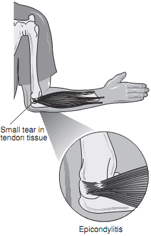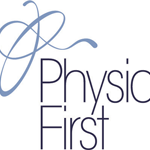TENNIS ELBOW
What is tennis elbow?
Tennis elbow is tenderness or pain on the outer side of the elbow. In most cases the pain only occurs when you use the forearm, particularly on gripping and twisting movements such as turning a door handle. In some cases the pain is constant. About 1 in 100 adults develop tennis elbow each year. It largely occurs between the ages of 30 and 50.
True tennis elbow is pain localised on the outside of the elbow. Your Physiotherapist will also check your neck and elbow joint as pain from these areas can also refer. It is important to exclude other potential causes in the diagnosis of tennis elbow. Make sure you tell your doctor or physiotherapist if you experience any upper back or shoulder pain or any nerve symptoms such as pins and needles or numbness.
What causes tennis elbow?
The site of the pain is where tendons from the forearm muscles attach to the bone. The pain is thought to be due to an injury, or several tiny injuries, to the tendon. The injury may cause a tiny tear to the tendon. The injuries are usually caused by overuse of the forearm muscles in repeated actions which involve significant amounts of gripping and twisting. Playing tennis or other racquet sports can also cause the onset. It is more likely to develop if you hit a high percentage of backhands or play with a weak wrist. A sudden increase in activities that challenge weak forearm muscles will make this area vulnerable to injury. For example, playing a lot of tennis on holiday. However, even if you are used to heavy work, you can overdo it and injure a tendon. In some cases the condition develops for no apparent reason without any prior overuse or injury to the arm.
Conservative Management of Tennis Elbow
The aim of conservative treatment is to:
- reduce the stress on the tendon so that your body can try to heal the area.
- break the pain cycle
How to reduce the stress on the tendon
- Stop the particular activity that causes the pain or find a different way of doing it. For example, you may need to adjust your backhand if playing tennis to use your shoulder and elbow more than your wrist and elbow.
- If you are involved in a sport or profession that uses repetitive movements you may need to adjust your technique. Your Physiotherapist will be able to give you advice on your movement patterning as well as appropriate stretching and strengthening exercises.
- Altering the grip size on objects you use may have a beneficial effect. Broadening the grip is also helpful as well as reducing the weight of rackets or tools.
- Using a splint or brace may help. Braces which support the elbow but still allow freedom of movement are typically best. Place the support just below your elbow over the painful area. The pain relief should be immediately noticeable. Wear the support when using the arm and remove it when resting or at night.
Tip
Be aware of the amount of force that you use to grip things, look at your knuckles, are they white? If they are this suggests that you are gripping too hard. Try to use the minimum amount of force to achieve the task.
How to break the pain cycle
Specific treatments also help accelerate pain relief.
- Massage an ice cube over the area for up to 10 minutes when painful (ensure you keep the ice moving so you avoid ice burns).
- Use a local anti-inflammatory cream on the area. (Available from the chemist without a prescription, but check with the pharmacist that you have no allergies or conditions that are influenced by these drugs).
- Pain medication. Discuss appropriate anti-inflammatory medications or pain killers with a pharmacist.
- Physiotherapy. A thorough assessment will guide the best approach to management. Local modalities such as ultrasound can be used to influence pain and promote tissue repair. Acupuncture can also be very helpful in pain relief. If there are areas of soft tissue tightness, soft tissue work will help to restore mobility into these muscles.
- Injection of a local anaesthetic and steroid into the area by your doctor or consultant can help alleviate local discomfort and stop inflammation. Generally doctors do not want to give more than 3 injections in a year. If your symptoms keep returning other treatment methods may be suggested.





